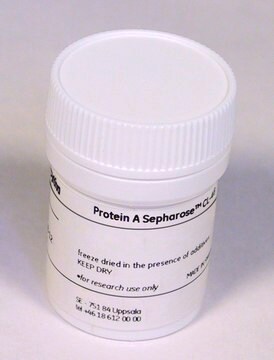16-156
Protein A-Agarose, Fast Flow
Protein A Agarose, Fast Flow suitable for medium and low-pressure chromatography, immunoprecipitation and antibody purification.
Synonym(e):
Protein A resin
Anmeldenzur Ansicht organisationsspezifischer und vertraglich vereinbarter Preise
Alle Fotos(1)
About This Item
UNSPSC-Code:
41116133
eCl@ss:
32160801
NACRES:
NA.56
Empfohlene Produkte
Form
liquid
Hersteller/Markenname
Upstate®
Methode(n)
affinity chromatography: suitable
immunoprecipitation (IP): suitable
western blot: suitable
Versandbedingung
wet ice
Allgemeine Beschreibung
Protein A ist ein Immunglobulin (Ig)-Bindungsprotein, das zum Aufreinigen großer Mengen IgG verwendet wird. Es bindet den Fc-Teil des Antikörpers an der CH2–CH3-Grenzfläche. Protein A-Agarose könnte für die Antikörperisolation bei niedrigem Druck geeignet sein.
Rekombinantes Protein A, das kovalent an hochgradig vernetzte 6%ige Agarose-Beads gebunden ist.
Bindungskapazität: 40 mg Human-IgG/ml Agarose
Rekombinantes Protein A, das kovalent an hochgradig vernetzte 6%ige Agarose-Beads gebunden ist.
Bindungskapazität: 40 mg Human-IgG/ml Agarose
Anwendung
Protein A-Agarose, Fast Flow wird in Immunpräzipitation und Chromatin-Immunpräzipitation (ChIP) eingesetzt.
Qualität
Regelmäßig mittels Immunpräzipitation beurteilt
Physikalische Form
Steriles destilliertes Wasser mit 0,01 % Thimerosal
Rechtliche Hinweise
UPSTATE is a registered trademark of Merck KGaA, Darmstadt, Germany
Lagerklassenschlüssel
10 - Combustible liquids
WGK
WGK 1
Analysenzertifikate (COA)
Suchen Sie nach Analysenzertifikate (COA), indem Sie die Lot-/Chargennummer des Produkts eingeben. Lot- und Chargennummern sind auf dem Produktetikett hinter den Wörtern ‘Lot’ oder ‘Batch’ (Lot oder Charge) zu finden.
Besitzen Sie dieses Produkt bereits?
In der Dokumentenbibliothek finden Sie die Dokumentation zu den Produkten, die Sie kürzlich erworben haben.
Kunden haben sich ebenfalls angesehen
Simon Schenk et al.
American journal of physiology. Endocrinology and metabolism, 291(2), E254-E260 (2006-05-04)
Although the increase in fatty acid oxidation after endurance exercise training has been linked with improvements in insulin sensitivity and overall metabolic health, the mechanisms responsible for increasing fatty acid oxidation after exercise training are not completely understood. The primary
Ghia M Euskirchen et al.
Genome research, 17(6), 898-909 (2007-06-15)
Recent progress in mapping transcription factor (TF) binding regions can largely be credited to chromatin immunoprecipitation (ChIP) technologies. We compared strategies for mapping TF binding regions in mammalian cells using two different ChIP schemes: ChIP with DNA microarray analysis (ChIP-chip)
Lei Jiang et al.
Investigative ophthalmology & visual science, 61(5), 41-41 (2020-05-24)
To identify the pathogenic gene of infantile nystagmus syndrome (INS) in three Chinese families and explore the potential pathogenic mechanism of FERM domain-containing 7 (FRMD7) mutations. Genetic testing was performed via Sanger sequencing. Western blotting was used to analyze protein
Yong Cheng et al.
Nature, 515(7527), 371-375 (2014-11-21)
To broaden our understanding of the evolution of gene regulation mechanisms, we generated occupancy profiles for 34 orthologous transcription factors (TFs) in human-mouse erythroid progenitor, lymphoblast and embryonic stem-cell lines. By combining the genome-wide transcription factor occupancy repertoires, associated epigenetic
Vasavi Sundaram et al.
Genome research, 24(12), 1963-1976 (2014-10-17)
Transposable elements (TEs) have been shown to contain functional binding sites for certain transcription factors (TFs). However, the extent to which TEs contribute to the evolution of TF binding sites is not well known. We comprehensively mapped binding sites for
Unser Team von Wissenschaftlern verfügt über Erfahrung in allen Forschungsbereichen einschließlich Life Science, Materialwissenschaften, chemischer Synthese, Chromatographie, Analytik und vielen mehr..
Setzen Sie sich mit dem technischen Dienst in Verbindung.









